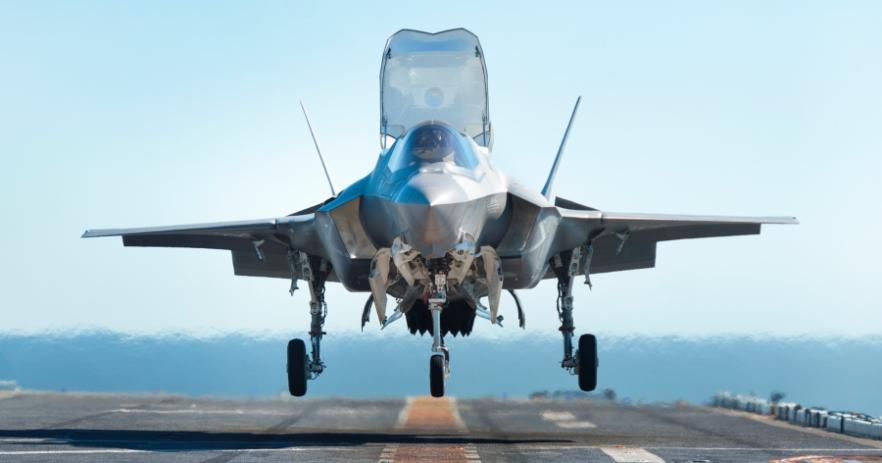The F-35 and the Eurofighter Typhoon are the frontrunners to replace Spain’s aging fleet of F-18 Hornets. Despite the government’s plans to join a Franco-German initiative to develop a new European fighter plane, the Spanish Navy and Air Force remain interested in the American F-35 and Eurofighter Typhoon.
According to the reports, Madrid is considering two options for replacing its outdated Hornets, the first of which involves its 20 oldest platforms, which are currently stationed in the Canary Islands.
The other seeks to replace the air force’s larger F-18 fleet, which is based in Zaragoza and Torrejón. The Lockheed Martin F-35 and new Eurofighters are being considered for this initiative.
According to Col. Jesus Ferrer, chief of coordination for fixed-wing systems for Spain’s military procurement office, it may come down to one major factor: whether the Navy opts to buy about a dozen F-35B vertical-takeoff-and-landing (VTOL) aircraft.
“If they get the F-35, one option for the Spanish air force will be to purchase the F-35, but we are weighing all the options,” he was quoted as saying by Defense News.

He said that Typhoon is still in the contest and that they are looking into all possibilities. The wider F-18 fleet is expected to last until at least 2030, but Spain is aiming to replace its 20 Canary Islands-based planes as soon as possible.
In the 1980s, the F-18 enabled the Air Force to make a giant leap forward in terms of technological capability. However, the fleet is already 30 years old, and most aircraft have accumulated more than 5,000 hours of flight time, with a maximum of over 7,000 hours.
The 20 aircraft in the Canary Islands, out of the 86 currently in operation, are in the most desperate need of replacement.
There are 13 Harriers in service with the Spanish Navy at the moment (though one is a trainer). These planes can be operated from Spain’s amphibious assault ship Juan Carlos I and currently, the F-35B is the sole viable option in the market for replacing the Harriers.
The latter are piloted and maintained by the Novena Escuadrilla de Aeronaves (9th Aircraft Squadron).

Eurofighter Typhoon
As part of a previous purchase that was delivered last year, the Spanish Air Force already has 73 Eurofighters, including 59 single-seaters and 14 twin-seaters. However, three of these have been lost in accidents.
The Typhoons are delivered in “tranches,” each with its own set of avionics and capabilities. The present Spanish Air Force fleet of 73 aircraft consists of 19 Tranche 1, 34 Tranche 2, and 20 Tranche 3 aircraft.
The remaining 17 out of 19 Tranche 1 units will be upgraded to Tranche 2 and Tranche 3 equipment, providing them with complete multi-role capabilities. The new Eurofighters will be Tranche 3+/Tranche 4 aircraft.
The manufacturer announced last year that they are in negotiations with the Spanish government for the replacement of 20 Spanish Air Force F-18 Hornets under Project Halcón, or Project Hawk, as previously reported by EurAsian Times.

The Eurofighter consortium is offering 20 new Typhoons to replace the older Hornets, which will be equipped with the Captor-E Mk 1 active electronically scanned array (AESA) radar.
Despite its lack of stealth, the Eurofighter Typhoon is considered the world’s most modern swing-role combat aircraft, capable of simultaneously deploying air-to-air and air-to-surface capabilities.
The Typhoons have proven operational capabilities by adding weapons like Paveway IV, Storm Shadow, Meteor, Brimstone II, and other elements of a ‘Phased’ enhancement program, as well as conducting combat operations like Operation Shader over Syria and Iraq, and also NATO air policing missions in the Baltics.
Apart from Spain, many other countries have already purchased it because of its agility and maneuverability, including Germany, the United Kingdom, Italy, Austria, Saudi Arabia, and Oman, Kuwait, and Qatar.
F-35B Alternative To The Harrier?
The Spanish Air Force and Navy are eyeing Lockheed Martin’s F-35 Lightning II joint strike fighter to replace the F-18s and vertical take-off Harriers that will be phased out midway through the next decade.
If the Navy wants to keep its ability to launch air power from a ship, then it has no choice other than going for the F-35B. The service will have to phase out its remaining Harriers, leaving only the F-35s as the sole jets capable of vertical/short takeoff and landing (V/STOL). The Navy’s ship, the Juan Carlos I, would be reduced to a helicopter carrier without them.

Navy officials are well aware that the F-35 is too expensive, and that their procurement of 12 to 15 jets would leave little room for negotiation. But, according to high-ranking Navy sources, things would be different if the Air Force ordered the same model.
The F-35B’s cost, both in terms of operating and purchase price is the most significant barrier for Madrid. However, Air Force officials claim that the Eurofighter will not be able to compete with the F-35, a fifth-generation fighter with integrated sensors on the pilot’s helmet that provide a 360-degree view.
They also claim that reliance on a single type could leave the Air Force vulnerable if the Eurofighters develop structural problems.
However, there is one more fundamental issue with the F-35 purchase: the funds allocated to the F-35B do not support European industry, employment, or research and development, which means the Spanish government prefers to invest in the Future Combat Air System (FCAS) sixth-generation fighter program.
- Contact the author at ashishmichel@gmail.com
- Follow EurAsian Times on Google News




